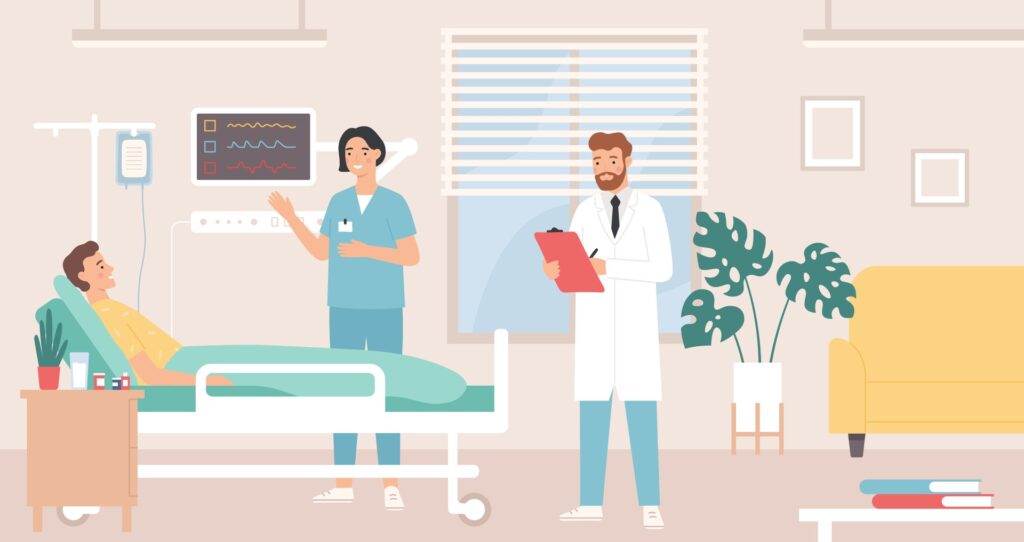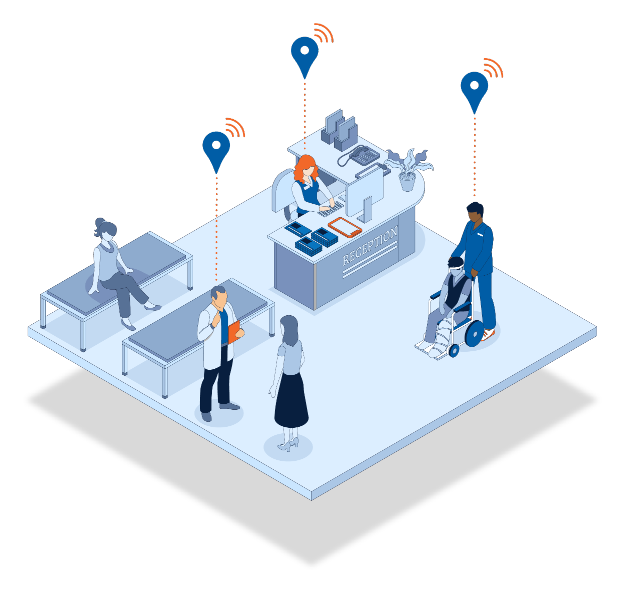What Is Patient Flow and Why Does It Matter?
Patient flow refers to the coordinated movement of patients through every stage of care—from admission and diagnosis to treatment and discharge. Efficient patient flow is essential to delivering high-quality, timely care, reducing wait times, and improving both patient satisfaction and health outcomes.
Hospitals face common bottlenecks such as emergency department overcrowding, delayed discharges, and staff coordination challenges. Addressing these issues requires a hospital-wide, multidisciplinary approach supported by strong leadership and the right technology.
Effective patient flow management helps increase patient throughput, reduce operational costs, and improve resource utilization. By leveraging tools like real-time location systems (RTLS), electronic health records, and advanced analytics, healthcare organizations can gain real-time visibility into patient movement and make data-driven decisions that improve care delivery.
Ultimately, optimizing patient flow is not just about efficiency—it’s about enhancing patient safety, boosting staff productivity, and ensuring every patient receives the right care at the right time.
The Role of RTLS in Improving Patient Flow

What is RTLS (Real-Time Location System)?
AiRISTA is a leading provider of Real-Time Location System (RTLS) solutions, helping organizations improve safety, efficiency, and visibility through precise location tracking.
RTLS (Real-Time Location System) is a technology used to automatically identify and track the location of people, assets, or equipment in real time, typically within a building or defined area. AiRISTA’s RTLS solutions use a combination of tags, sensors, and software to deliver accurate location data that enhances workflows, reduces bottlenecks, and supports critical operations—especially in healthcare, manufacturing, and logistics environments.
Overview of how RTLS supports better visibility and coordination
RTLS supports better visibility and coordination by providing real-time data on the location and status of patients, staff, and equipment. This enhanced visibility allows healthcare providers to make more informed decisions, streamline workflows, and improve patient care. For example, in inpatient units, RTLS can help in automating discharge planning and identifying barriers to timely patient discharge, thereby optimizing patient flow and reducing the length of stay.
Benefits of real-time tracking for both patients and staff
Real-time tracking offers numerous advantages for both patients and healthcare staff—and AiRISTA’s RTLS (Real-Time Location System) platform delivers these benefits through advanced location intelligence and customizable workflows.
In operating rooms, AiRISTA’s RTLS helps optimize utilization by providing accurate, real-time data on room occupancy, equipment availability, and surgical team readiness. This insight enables smarter scheduling, faster room turnover, and timely release of blocked OR time, ultimately increasing surgical capacity and reducing patient wait times.
Beyond the OR, AiRISTA’s RTLS improves overall healthcare efficiency by ensuring the right resources are in the right place at the right time. By streamlining workflows and reducing delays, healthcare teams can deliver higher-quality care while enhancing staff productivity and operational effectiveness.
Key Challenges in Patient Flow—And How RTLS Solves Them
Hospitals face a range of challenges that slow patient flow and impact care quality. AiRISTA’s RTLS (Real-Time Location System) provides real-time visibility and automated workflows to address these common bottlenecks:
Emergency Department (ED) Overcrowding:
- AiRISTA’s RTLS delivers real-time location data and patient status updates to help bed management teams identify open beds faster, reducing ED boarding times.
Delayed Discharges:
- RTLS improves discharge coordination by alerting staff when patients are medically ready for discharge, streamlining room turnover and reducing delays caused by administrative or post-acute care bottlenecks.
Poor Communication and Coordination:
- AiRISTA’s RTLS enables automated alerts and shared visibility across departments, minimizing manual handoffs and improving coordination for patient transfers, bed assignments, and care transitions.
Limited Visibility into Bed Availability:
- With real-time tracking of patient locations and bed status, AiRISTA’s RTLS empowers teams to match patients to available beds quickly, enhancing capacity management.
Patient Transport Delays:
- RTLS tracks patient movement and transport team status, enabling dispatchers to prioritize requests and reduce internal transport delays.
By addressing these challenges with AiRISTA’s RTLS, hospitals can improve patient flow, reduce wait times, and enhance overall care delivery.
Strategies for Improving Care Delivery with RTLS
Improving patient flow requires a multifaceted approach—and real-time location systems (RTLS) are critical in enabling many of these strategies. AiRISTA’s RTLS platform enhances care delivery by providing real-time visibility into the location and status of patients, staff, and critical assets. This location intelligence supports streamlined clinical workflows by automating status updates, reducing manual handoffs, and ensuring the right resources are available exactly when and where they’re needed.
Hospitals can leverage RTLS data from AiRISTA to optimize space utilization and physical layout by analyzing traffic patterns, dwell times, and room usage. These insights inform smarter decisions about room assignments, department placement, and equipment allocation—ultimately improving throughput and reducing bottlenecks.
RTLS also improves interdepartmental communication by offering a shared, real-time view of patient movement and resource availability. Instead of relying on phone calls or manual logs, staff can coordinate seamlessly through automated alerts and dashboards that update in real time.
Dedicated patient flow teams can use AiRISTA’s RTLS data to identify operational bottlenecks—such as transport delays, room turnover gaps, or discharge backlogs—and take corrective action quickly. Integrated reporting and analytics provide continuous performance monitoring, supporting data-driven process improvement and accountability.
RTLS also enables hospitals to apply lean principles more effectively by pinpointing inefficiencies and eliminating waste in real time. Whether reducing idle bed time, accelerating patient transfers, or minimizing unnecessary staff searches, AiRISTA’s RTLS empowers healthcare facilities to operate more efficiently. Combined with patient-centered care models, RTLS ensures patients move through the care continuum safely, smoothly, and without unnecessary delays—resulting in better outcomes and improved patient satisfaction.
Real-World RTLS Applications That Improve Patient Flow
Emergency Department Optimization
Optimizing the emergency department is crucial for hospital-wide patient flow, ultimately improving outcomes. By streamlining processes and reducing wait times, hospitals can enhance patient care and overall experiences. Implementing advanced tracking systems ensures that patients receive timely attention, which is essential for better health outcomes.
Operating Room Turnaround
Efficient operating room turnaround is vital for maximizing the use of surgical suites and reducing patient wait times. By employing real-time location systems (RTLS), hospitals can track equipment and staff, ensuring that surgeries start on time and resources are utilized effectively. This not only improves operational efficiency but also enhances patient satisfaction.
Radiology and Imaging Efficiency
RTLS can significantly enhance the care continuum in radiology and imaging departments. By providing real-time tracking of patients, staff, and equipment, RTLS ensures that imaging procedures are conducted promptly and efficiently. This integration within the healthcare system facilitates better collaboration among healthcare professionals, ultimately improving patient outcomes and operational efficiency.
Self-rooming and Virtual Waiting Rooms
Self-rooming and virtual waiting rooms are innovative solutions that improve patient flow and reduce congestion in waiting areas. By allowing patients to check in and proceed directly to their assigned rooms, hospitals can minimize wait times and enhance the overall patient experience. These systems also provide real-time updates to both patients and staff, ensuring smooth and efficient operations.
Data-Driven Improvements with RTLS
Uncovering Workflow Blind Spots with Location Data
AiRISTA’s RTLS platform provides real-time, location-based insights that uncover workflow inefficiencies and hidden bottlenecks across hospital operations. By leveraging AiRISTA’s advanced analytics and customizable dashboards, healthcare teams gain visibility into patient movement, staff activity, and resource utilization. This data empowers organizations to match capacity with patient demand, optimize resource allocation, and enhance patient flow—reducing delays and improving overall satisfaction for both patients and staff.
Automated Cycle Time Tracking
AiRISTA enables automated tracking of the entire patient journey—from check-in to discharge—providing continuous visibility into bed status, patient handoffs, and hospital capacity. With real-time data on patient movement and care transitions, care teams can quickly identify and resolve delays, improving throughput and shortening patient wait times. By streamlining bed turnover and reducing bottlenecks, AiRISTA’s RTLS helps hospitals maximize efficiency while maintaining high standards of care.
Staff Productivity Insights
AiRISTA’s RTLS platform captures detailed data on staff locations, availability, and response times, offering actionable insights to improve workforce productivity. Administrators can use this data to refine staffing models, optimize patient-to-staff ratios, and eliminate unnecessary delays in care delivery. By enabling data-driven decisions, AiRISTA supports a healthier work environment, boosts staff satisfaction, and enhances patient outcomes..
Benefits of RTLS for Hospital Staff and Administrators
Reduced stress and burnout: RTLS can help prevent potential harm by reducing stress and burnout among hospital staff. By streamlining workflows and providing real-time location data, RTLS ensures that staff can focus on patient care without the added pressure of manual tracking and coordination.
Improved patient-to-staff ratio management: RTLS plays a crucial role in managing different staffing models to improve patient-to-staff ratios. By utilizing a data-driven approach, hospitals can strategically adjust staffing routines to match patient demand, enhancing care efficiency and reducing delays.
Fewer manual updates and status checks
Why RTLS Is a Scalable Solution for Modern Hospitals
RTLS (Real-Time Location Systems) is inherently scalable, making it an ideal solution for modern hospitals navigating growing demands and evolving care environments. AiRISTA’s RTLS platform is designed to grow alongside healthcare organizations, whether starting with a targeted use case—such as staff safety or asset tracking—or expanding into enterprise-wide patient flow management.
With a flexible architecture, AiRISTA’s RTLS supports phased rollouts, seamlessly integrates with electronic health records (EHR), nurse call systems, and other hospital technologies, and adapts to diverse clinical environments and building layouts. This flexibility allows hospitals to implement RTLS at their own pace while preparing for future needs.
As hospitals face increasing pressure to improve efficiency with limited resources, AiRISTA’s RTLS provides real-time visibility and automation to enhance safety, streamline operations, and improve patient experiences—without requiring a complete infrastructure overhaul. Its modular design enables hospitals to easily scale by adding new use cases over time, such as hand hygiene monitoring, environmental monitoring, surgical suite optimization, or expanded patient flow capabilities.
By improving transparency in bed availability, facilitating collaboration across departments, and eliminating bottlenecks, AiRISTA’s RTLS empowers hospitals to optimize patient flow, increase discharge rates, and maintain high standards of care. The result is a scalable, future-ready platform that delivers measurable ROI while supporting long-term strategic goals.
Improving Patient Flow in Hospitals: Final Takeaways
Summary of top RTLS benefits
- Enhanced Patient Flow & Satisfaction: RTLS significantly improves patient flow by optimizing the entire patient journey. From admission to discharge, RTLS streamlines processes, reduces wait times, and addresses logistical challenges—leading to higher patient satisfaction, which can positively impact HCAHPS scores in U.S. healthcare systems.
- Increased Revenue Potential: For U.S. providers, improving patient flow with RTLS can directly increase revenue by enabling hospitals to see more patients without compromising quality of care. Faster throughput and fewer bottlenecks help maximize operational capacity.
- Improved Resource Utilization: By providing real-time data on the location and status of equipment and staff, RTLS ensures resources are used efficiently, reducing waste and improving day-to-day hospital operations.
Long-term operational value and ROI
- Addressing Underlying Causes: For lasting impact, it’s critical to address the root causes of inefficiencies. Multidisciplinary teams can leverage RTLS data to uncover these underlying issues and develop targeted solutions that enhance patient flow and hospital performance over time.
- Cost Savings & Financial Impact: Implementing RTLS leads to measurable cost savings by reducing equipment loss, optimizing staff allocation, and minimizing patient wait times. In U.S. healthcare systems, these efficiencies translate to both cost reduction and increased revenue opportunities—creating a stronger bottom line.
Encouragement to explore RTLS for better hospital-wide outcomes
Investing in RTLS technology can transform hospital operations by enhancing the patient journey and addressing underlying causes of inefficiencies. Explore RTLS solutions to achieve better hospital-wide outcomes and improve patient satisfaction.
Explore AiRISTA’s RTLS Solutions
Discover how AiRISTA’s cutting-edge RTLS solutions can transform your healthcare facility by visiting our healthcare RTLS solutions page. Our innovative applications are designed to enhance patient flow management, ensuring efficient patient flow across hospital-wide operations. By leveraging advanced data analytics and patient tracking systems, our solutions improve operational efficiency and patient satisfaction. To experience the benefits firsthand, book a demo or contact our sales experts for tailored recommendations. Let us help you optimize your hospital’s patient journey and ultimately improve health outcomes.





